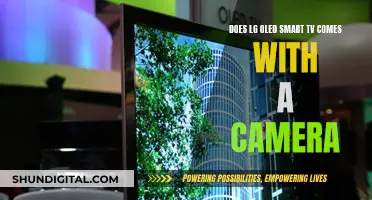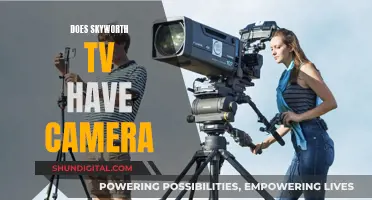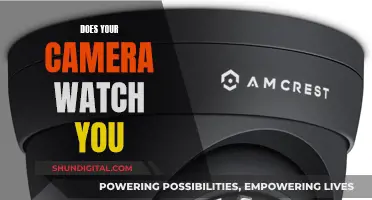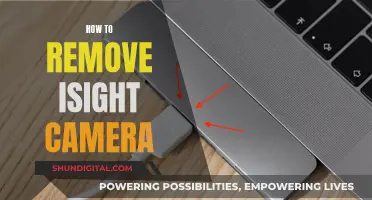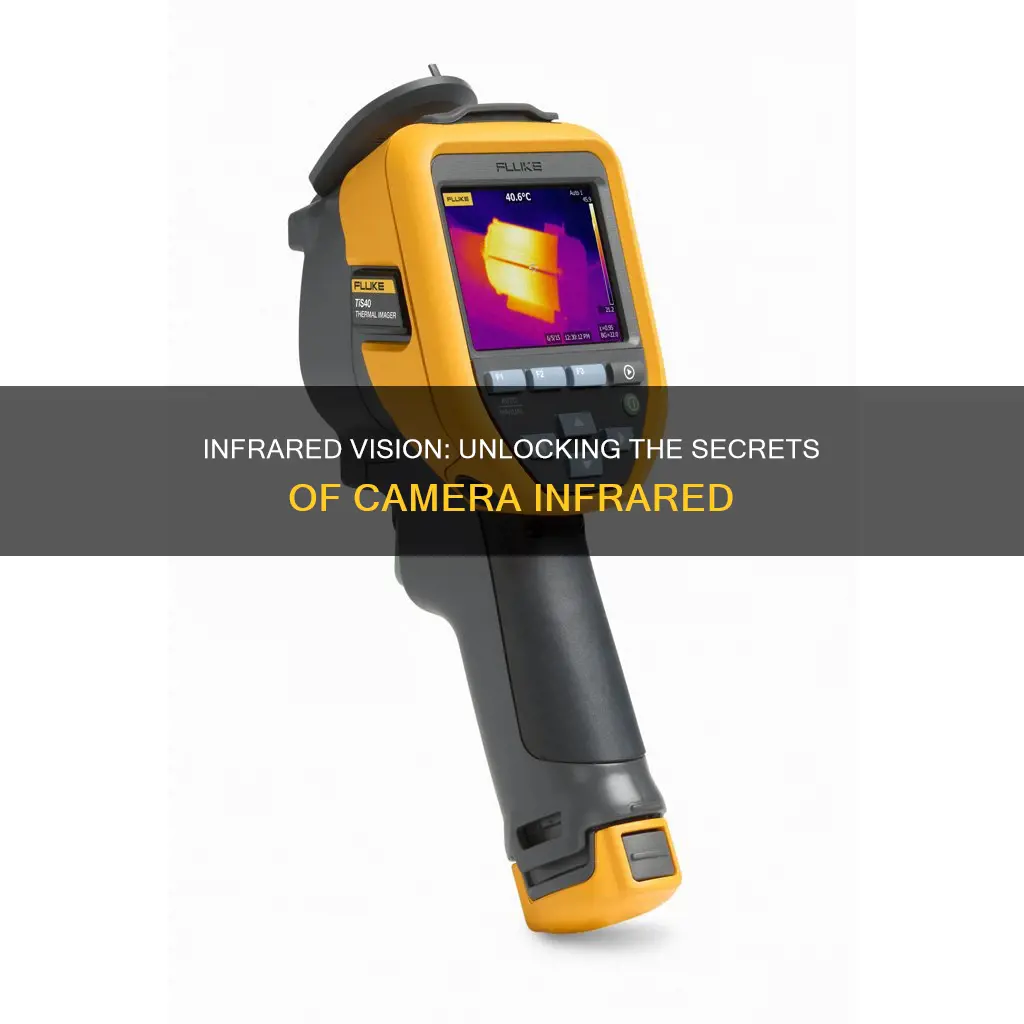
Infrared light is invisible to the naked eye, but there are a few ways to see it. One simple way is to use a remote control while looking through a camera—you should see a small flash of light, which is the infrared light emitting from your remote. Another way is to make your own infrared goggles by purchasing welding goggles with removable lenses and using blue and red stage lighting gels as lenses.
| Characteristics | Values |
|---|---|
| Infrared light visibility to the naked eye | Invisible |
| Infrared light visibility with a smartphone | Visible |
| Infrared light visibility with a camera | Visible |
| Infrared light visibility with infrared goggles | Visible |
| Infrared light wavelength | Just past visible red light |
| Infrared camera other names | Night vision camera |
| Infrared camera use case | Capturing moments in low light or in the dark |
| Infrared camera light frequency | 430 THz down to 300 GHz |
| Infrared camera light visibility to the naked eye | Invisible |
| Digital camera infrared light visibility | Visible as white or blue light |
| iPhone rear camera infrared light visibility | Not visible due to IR filter |
| iPhone front camera infrared light visibility | Visible |
| Remote control infrared light visibility to the naked eye | Not visible |
| Remote control infrared light visibility with a camera | Visible |
What You'll Learn

Using a smartphone camera
Smartphones are a convenient way to detect infrared light. You can use any smartphone camera, but some phones may only be able to detect IR light with the front-facing camera. To test this, simply turn on your camera app and aim it at a remote control. Press a button on the remote, and if you see a small light, your phone is able to detect IR light with that camera.
Infrared light is invisible to the naked eye, but the sensors in your smartphone camera can detect it. This is because the camera is more sensitive to light than the human eye.
To see the infrared light emitted by a TV remote, shine the remote at your phone camera and press a button. You should see a small flash of light, which is the infrared light that is invisible to us. Each button sends different pulses of infrared light, which tell your TV what to do.
You can also use your smartphone to find hidden cameras. If a camera is using infrared light, your phone's sensor should be able to pick it up. To do this, make the room as dark as possible, and then slowly scan the room with your phone. If there is an active camera with infrared lighting, you should be able to find it.
Accessing Your Camera Feed Remotely: A Guide
You may want to see also

Using a video recorder
A video recorder can be used to detect infrared light. The simplest way to do this is by pointing a remote control at the video recorder and pressing a button. The small flash of light that is seen is the infrared light emitting from the remote control. This method can be used to test whether a remote control is working.
Most modern cameras have infrared filters, which block infrared light so that they capture the clearest images. To make a camera see infrared light, the infrared filter must be removed. This can be done by removing the manual focusing ring on the outside of the lens and then using a sharp, small pin to pop out the filter. After removing the filter, the manual focusing ring should be reattached. The camera should now be ready to view objects at infrared wavelengths.
To make the infrared reading even stronger, polarized filters can be used to block most of the visible light. Two polarized filters, one vertical and one horizontal, can be taped to the front of the camera lens. This should allow the camera to pick up almost only infrared wavelengths.
It is important to note that not all video recorders will be able to detect infrared light. Some newer phones, for example, block IR with the regular camera but pick it up with the selfie camera. Older phones and some selfie/wide-angle cameras can still see it. Additionally, some newer remotes use Bluetooth, so they will not emit infrared light.
Real-Life Cameras: How They See You
You may want to see also

Making infrared goggles
Infrared light is invisible to the naked eye, but with a few simple tools, you can make your own infrared goggles to see this light for yourself.
Materials
To make your own infrared goggles, you will need:
- A pair of welding goggles with removable lenses
- Two sheets each of blue and red stage lighting gels, specifically "Congo Blue" (ROSCO 382 or LEE C181) and "Primary Red" (ROSCO 27 or LEE C106)
- Painter's tape and black spray paint (optional)
Step 1: Prepare the Goggles
If your welding goggles are not already black, cover the lenses with painter's tape and spray paint the goggles black, inside and out. Let the goggles dry between coats.
Step 2: Cut the Lighting Gels
Use the original lenses as a guide to trace and cut out eight blue gels and two red gels. Handle the gels carefully to avoid scratches and fingerprints, which can damage the plastic.
Step 3: Assemble the Goggles
Insert four blue gels into the eyepiece assemblies, and then screw them back onto the goggles. For another effect, you can add the red gels to each eyepiece to enhance the infrared viewing experience.
Step 4: Test Your Goggles
Put on your goggles and go outside on a bright, sunny day. Do not look directly at the sun as this can cause serious and permanent eye damage. With your goggles on, the sky should appear dark, while trees and bushes take on a pink hue.
Tips
- You can use your infrared goggles to see secret messages. For example, cut out squares of blue and red filters from leftover lighting gels and layer them to make an opaque black barrier that only becomes transparent when viewed through the goggles. Hide messages behind the barrier.
- You can also use your goggles to see a narrow band of infrared light by passing sunlight through a prism.
Viewing Histograms: In-Camera LCD Screen Guide
You may want to see also

Using a remote control
Infrared light is all around us, but it's invisible to the naked eye. However, you can use a remote control and a digital camera, smartphone, or camcorder to detect it. Here's a step-by-step guide:
Step 1: Gather Your Materials
To detect infrared light, you will need a remote control and a device that can record video or capture images. The remote control should have a small light bulb at the top, which emits infrared light when you press a button. For the detecting device, you can use a smartphone (especially newer models), a digital camera, or a camcorder.
Step 2: Test Your Remote Control
Before you begin, ensure your remote control is working by pressing a button. If it doesn't respond, try changing the batteries or using a different remote. This step is important because you need a functioning remote to emit infrared signals.
Step 3: Press a Button on the Remote
Now, press any button on your remote control. It doesn't matter which button you press, as long as the remote is on and working. Even if you're in a different room from the device the remote usually controls, it will still emit infrared light when you press the buttons.
Step 4: Observe Through Your Device
Turn on your chosen recording device and focus on the top light bulb of the remote control through the camera. While looking at the remote's light bulb, press any button. You should see a small flash of light, which is the infrared light being emitted by the remote as it sends signals to the device it controls.
If you don't see the flash of light, check your remote's batteries or test it again, as the remote may be faulty. Additionally, some smartphone cameras have IR filters that prevent the detection of infrared light, so you may need to try a different device if you don't see anything.
Troubleshooting:
If you see the infrared light without pressing a button, one of the buttons on the remote may be stuck. To fix this, remove the batteries, press and release each button a few times, and then reinsert the batteries and test again. If the issue persists, you may need to replace the remote control.
By following these steps, you can use a remote control and a camera-enabled device to detect and observe infrared light, which is usually invisible to the human eye. This simple experiment showcases the hidden signals all around us and provides insight into how technology communicates.
How to Find the Camera on Your Vizio Smart TV?
You may want to see also

Using a hidden camera detector app
- Scan your surroundings carefully: Take time to visually assess the location. In many cases, hidden cameras are poorly assembled, with wires and circuitry visible, or otherwise not well-hidden. That’s why simple visual assessments are important.
- Focus your search on private areas: If you are scanning a house, focus your search on private areas, like the bedroom.
- Look out for unfamiliar objects: Keep an eye out for unfamiliar objects or objects that have moved, even slightly. Inspect them thoroughly if you notice anything out of the ordinary.
- Check inside smoke detectors and lighting fixtures: Use a flashlight to look inside smoke detectors and lighting fixtures on the ceiling, making sure to turn off the electricity beforehand.
- Download a hidden camera detector app: There are numerous free apps to detect hidden cameras and microphones that are available for iOS and Android devices. You can try apps like Hidden Camera Detector, DontSpy 2, Glint Finder, or Hidden Spy Camera Detector.
- Scan the area for hidden cameras: Once you have downloaded the app, open it and scan the area for any hidden cameras. The app will alert you if any infrared lights or other suspicious indicators are detected.
- Act on your findings: If you find a hidden camera, you can take it to a higher authority, such as the police. In the meantime, you can also act to protect yourself against spying by covering the camera with masking tape or adhesive putty, or by conducting your affairs beyond the camera's viewing angle.
Xbox One's Camera: Watching You?
You may want to see also
Frequently asked questions
Digital cameras can sense IR light. It will show up as a visible white or blue light on your camera preview.
No, any digital camera can detect IR light. However, there are apps that can help you detect IR light more clearly by minimizing brightness and using high-contrast filters.
Check if the camera is really based on IR technology and not something else. Also, check the position of the IR blaster in the camera and try switching off all the lights before performing the scan again.
Yes, you can use the remote control of any device. Point the remote towards the camera preview and press any button. You should be able to see a white/blue light that you won't see with your naked eye.
Infrared light is invisible to the naked eye. However, with the help of a few tools, you can view it. The simplest way is by using a remote control while looking through a camera.


